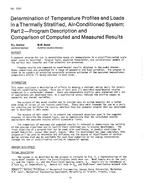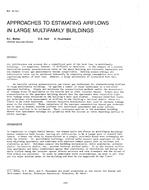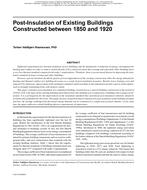This report summarizes the research performed for ASHRAE research project 746 to experimentally determine the air pressure difference required to stop the water vapor transmission through typical building wall materials caused by a water vapor pressure difference. Experimental data was obtained using 1 by 1 ft. (0.3 by 0.3 m) building wall samples placed between two controlled chambers. A smaller set of chambers was used to test the first of three different wall materials, a two inch thick concrete panel. A larger set of chambers was used to test for the water vapor transmission through a composite wall of gypsum board, cement block, and brick, and an eight inch thick concrete wall panel. Water vapor transmission data were obtained for a range of water vapor pressure differences and a range of opposing air pressure differences. Water vapor pressure differences were maintained by operating one side of the chamber at high temperature and humidity as indicative of warm “outdoor” conditions and the other side of the chamber, on the opposite side of the sample wall, at cooler, lower humidity indicative of “indoor” summer conditions. Water vapor transmission rates were obtained for zero air pressure difference and increasing air pressure differentials until the water vapor transmission was stopped or significantly reduced.
In addition to the experimental results, an analytical model was developed to describe the.air pressure difference to stop the water vapor transmission and the vapor transmission resulting from an applied air pressure differential. The model was developed into a simple computer code, AIRWALL. The AIRWALL code predicts the air pressure difference required to stop water vapor flow or the water vapor flow for a specified air pressure differential using known air permeability and water vapor permeability data for up to ten building composite wall components. The analytical model and the resulting computer code, AIRWALL, incorporate an algorithm to predict the air pressure and to stop the transfer of water vapor through a single wall material or through multiple component building walls (composite walls). The AIRWALL code consists of a menu driven selection of materials for a single wall material or composite of wall materials. The code utilizes some published air and water vapor permeability data and is compared to the experimental results of this research. The computer model is operational on a personal computer.
The experimental results and analytical model show that the water vapor transmission is a weak exponential function of water vapor pressure difference. A small opposing air pressure difference can significantly reduce water vapor transmission. Building wall materials that have relatively large air permeability and low water vapor permeability, require decreased air pressure differentials to stop or reduce water vapor transmission.
Product Details
- Published:
- 1995
- Number of Pages:
- 75
- File Size:
- 1 file , 1.8 MB
- Product Code(s):
- D-RP-746


